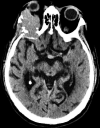The unusual first sign of presentation of renal cell carcinoma: a rare case report
- PMID: 36339908
- PMCID: PMC9634463
- DOI: 10.21037/acr-22-16
The unusual first sign of presentation of renal cell carcinoma: a rare case report
Abstract
Background: Renal cell carcinoma (RCC) usually is characterized by a slow pattern of growth, although with an unpredictable evolution and metastatic potential, favored by its extensive vascularity and related high angioinvasive profile. The most common sites of metastases from kidney cancer are lung, lymph nodes, bone and liver; whereas orbital metastases are very uncommon. In more than 25% of cases, orbital metastases are the first manifestation of a primary tumor of unknown origin. The clinical features of orbital metastases from kidney cancer are non-specific and could divert attention from the real problem.
Case description: In this article, we describe the case of a 72-year-old male patient reporting a painful mass on the right orbit, with exophthalmos and ptosis, as the first and unique signs of a previously undetected advanced RCC. Due to the clinical conditions, the patient underwent palliative radiation therapy delivered to the orbital lesion with the scope to relieve pain; subsequently started systemic therapy with pazopanib at the dose of 800 mg daily. Unfortunately, he did not achieve any benefit from systemic therapy, his conditions progressively worsened, and he finally passed away after four months of treatment due to rapid disease progression.
Conclusions: Despite its rarity, differential diagnosis of an orbital lesion should always consider the possibility of metastasis from RCC, performing an appropriate radiological evaluation.
Keywords: Case report; orbital metastasis; renal carcinoma; undiagnosed cancer.
2022 AME Case Reports. All rights reserved.
Conflict of interest statement
Conflicts of Interest: All authors have completed the ICMJE uniform disclosure form (available at https://acr.amegroups.com/article/view/10.21037/acr-22-16/coif). SDP reports consulting fees for Consulting or advisory Role: GSK, MSD, Seagen, Daiichi Sankyo, Lilly, Clovis, Celgene, Astrazeneca, Novartis, Pfizer, Roche; and Speaker’s Bureau: Celgene, Astrazeneca, Novartis, Pfizer, Roche. MG reports consulting fees for Consulting or advisory Role: Astrazeneca, MSD, Seagen, Daiichi Sankyo, Lilly, Celgene, Novartis, Pfizer; Speaker’s Bureau: Lilly, Celgene, Novartis, Pfizer, Istituto Gentili, Eisai Europe Ltd., Roche; Travel, accommodation, expenses: Novartis, Pfizer, Roche. The other authors have no conflicts of interest to declare.
Figures







Similar articles
-
Orbital metastasis of renal cell carcinoma masquerading as thyroid ophthalmopathy.Radiol Case Rep. 2025 Jan 15;20(4):1812-1815. doi: 10.1016/j.radcr.2024.12.052. eCollection 2025 Apr. Radiol Case Rep. 2025. PMID: 39897743 Free PMC article.
-
Orbital metastasis of renal cell carcinoma masquerading as cysticercosis.Orbit. 2008;27(5):370-3. doi: 10.1080/01676830802316688. Orbit. 2008. PMID: 18836935
-
Metastatic Renal Cell Carcinoma Presenting a Maxillary Mucosal Lesion as a First Visible Sign of Disease: A Case Report and Review of Literature.Diagnostics (Basel). 2025 Apr 7;15(7):938. doi: 10.3390/diagnostics15070938. Diagnostics (Basel). 2025. PMID: 40218288 Free PMC article.
-
[Exophthalmos caused by orbital metastasis of prostatic carcinoma].Arch Esp Urol. 1991 Mar;44(2):191-4. Arch Esp Urol. 1991. PMID: 1714262 Review. Spanish.
-
Metastatic tumors to the nail unit: subungual metastases.Dermatol Surg. 2001 Mar;27(3):280-93. Dermatol Surg. 2001. PMID: 11277898 Review.
Cited by
-
Orbital metastasis of renal cell carcinoma masquerading as thyroid ophthalmopathy.Radiol Case Rep. 2025 Jan 15;20(4):1812-1815. doi: 10.1016/j.radcr.2024.12.052. eCollection 2025 Apr. Radiol Case Rep. 2025. PMID: 39897743 Free PMC article.
-
Radical laparoscopic nephrectomy for a huge left renal mass in situs inversus totalis: A case report and video presentation.Urol Case Rep. 2025 Mar 31;60:103032. doi: 10.1016/j.eucr.2025.103032. eCollection 2025 May. Urol Case Rep. 2025. PMID: 40242038 Free PMC article.
References
Publication types
LinkOut - more resources
Full Text Sources
